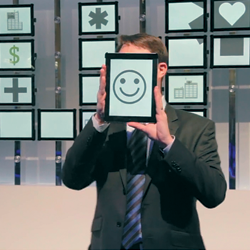|
case study
 photos: Steve Rossman Photo+Marketing; Shutterstock.com
The Art of Exhibiting
Exhibitus Inc. merges giant portraits, mind-bending sculpture, and a museum-like experience to create a marketing masterpiece that generates nearly 300 qualified leads. By Charles Pappas
As Exhibitus Inc. began revving up for EXHIBITORLIVE 2017, it realized it might have painted itself into a corner. A longtime exhibitor at the conference for face-to-face marketers, the Atlanta-based exhibit house felt its main challenge in 2017 was to answer a question prospective clients kept asking: "How do I get people to come into my booth and interact with my staff, then hear and remember my message?" The answer to the query, the company felt, was basic: good design. But conveying Exhibitus' conception of that good design was going to be anything but simple.
"We wanted our EXHIBITORLIVE experience to educate customers that the design of a company's booth is no longer just about arresting architecture and graphic messaging," says Brad Falberg, the company's president and founder. "We hoped to show attendees that design matters, but that good design today means the entire exhibiting program, from objective setting and effective targeting, messaging, and interaction to post-show measurement. The question and challenge we were then left with was what was the best way to do that?" To achieve its own objectives for the annual expo, the company began crafting its strategy. It started with the assumption it needed to draw and hold visitors long enough to deliver the multitiered message about design. The booth needed to be visually conspicuous, but it also had to be structured to allow for sufficient quality time with attendees to break down its message about good design's core elements. The solution, in part, came from nearly 7,000 miles away. Hendrik Lenze, a senior account executive at Exhibitus, had recently returned from South Korea, where a visit to an interactive art gallery gave him an idea he passed on to the rest of the company. Known for pushing the boundaries of artistic convention, the east Asian country's art galleries employ extravagant installations, outre performances, and beguiling technologies, with visitors often experiencing them via a sequential path and stops at various stations. A similar kind of experience, replicated in the company's booth, might likewise attract guests and keep them engaged, but with a small tweak. Instead of the self-guided tours common in art galleries, Exhibitus staffers would act much like museum docents, escorting attendees around artworks and enlightening them with insightful commentary. As it settled into a museum-inspired mindset, Exhibitus felt confident that a gallery-like experience would serve to arrest visitors' attention long enough to impart its messaging, while also separating those marketing messages and making them memorable. "You can easily pick out and remember a Picasso from a Van Gogh and a da Vinci, right?" Falberg says. "We wanted to bring that same distinctive quality to our individual messages." Even art must occasionally take a back seat to the more mundane matters of commerce and metrics, and the same was true when it came to the barometer with which Exhibitus would gauge its success. The company's main goal for the show was to amass 253 qualified leads, a figure based on a 10-percent increase over the previous year's results. Further, it wanted 30 percent of those qualified leads to verbally commit to taking an online self-assessment survey that would help Exhibitus hone in on their particular needs. Lastly, it hoped to receive requests for information (RFIs) or requests for proposal (RFPs) from at least 5 percent of the qualified leads sourced at the show. Artful Appetizers Pre-show promotions kept the booth's art-gallery design tightly under wraps to capitalize on the element of surprise. In December, January, and February, email newsletters, sent to a database of customers and top prospects, included offers of a VIP pass to the show and 10 percent off the cost of educational sessions, but contained no clue as to the actual booth experience. Then, in late February, an email and postcard mailer teased recipients with the first hint of what might be in store by instructing them that if they brought the missive to the Exhibitus booth, the company would donate an art kit to children in need. But even that teaser couldn't prepare targeted prospects for what was to come. When attendees neared the company's 20-by-30-foot booth, they beheld a space fit less for literature racks and banner stands than for an artist's magnum opus. To draw attention and encourage traffic flow on the floor, Exhibitus draped one exterior wall with a stunning 16-foot-tall silhouette of a female visage. Inspired by contemporary Spanish Impressionist Jose Royo and employing layers of opaque and backlit fabric, the picture brought to mind a photographic negative of one of Royo's Mediterranean temptresses. Sensual and even ravishing, the dramatic image paled next to the booth's piece de resistance. Looking like an Alexander Calder mobile dipped in a vat of Creamsicles (reflecting the company's official corporate hue), a sculpture hovering about 12 feet over the booth held attendees riveted. Comprising 360 Styrofoam "oranges" varying from 1 to 4 inches in diameter and hung with fishing wire from the white laminate canopy above, the airborne arrangement looked to a casual observer like little more than bushels of orange spheres randomly dangling in midair. A premier example of what's known as forced perspective, aka anamorphosis, the suspended structure required viewers to stand immediately in front of the reception desk in order for the seemingly disparate objects to align into a recognizable shape: the Exhibitus logo. The Art of Targeting The mobile was in some ways merely an amuse-bouche for the feast that awaited attendees' eyes and minds inside. At the reception counter, greeters scanned badges before handing off guests to any one of the roughly nine to 12 staff members available at any given time. Welcoming visitors into a modernist space of clear Lexan, laminate finishes, and sheer fabrics, staffers used the dazzling mobile as a natural icebreaker, asking the open-ended question "What do you think that sculpture looks like or represents?" Others plied guests with "What's in your exhibit/trade show engagement gallery?," a query begging comparison to the captivating portrait and dazzling mobile. This casual questioning helped attendees feel open to honest and somewhat intimate discussions with staffers.
A Work of Art
Exhibitus Inc. took EXHIBITORLIVE attendees on a four-part guided journey that used the works of great painters to convey lessons on the fine art of targeting, messaging, and engaging prospects.  The exhibit's artful theme was immediately conveyed by a seemingly random arrangement of suspended orange spheres that formed Exhibitus' logo only when viewed from a particular angle.  The Art of Targeting portion of the exhibit featured an interactive rendition of Seurat's "A Sunday on La Grande Jatte – 1884," which playfully illustrated various types of trade show attendees.  Staffers instructed attendees in how to craft tailored talking points at The Art of Messaging activation.  At The Art of Engagement station, booth visitors were encouraged to tweet a photo of themselves posing in front of a Magritte-inspired painting and include a show-specific hashtag.  In exchange for attendees adding their signatures to a rainbow-hued zebra print in The Art of Giving activation, Exhibitus made a donation in their name to the art-focused Dreaming Zebra Foundation. Staffers prompted participants to find the three attendees that should be their targets and weed out the ones that were of lesser value to exhibitors. Guests pressed a finger to any of seven figures among the immortalized cast of Parisians in the painting. Once a visitor touched, for example, the woman sitting under a sapphire blue parasol, a parchment-like scroll unfurled onscreen, identifying her as Tire-Kicker Tanya. This character, the scroll noted, was "uninvolved in the buying cycle" and had scant knowledge of her company's budget but was worth engaging with to the point of sending a follow-up email with more info. If attendees touched the dapper gentlemen with the rakish hat and walking stick, another scroll appeared onscreen pegging him as Boondoggle Bobby, someone "not involved in the buying cycle" because he was only trolling the trade show floor looking for the hottest party that night. Directing him to any booth offering 150-proof refreshments, Exhibitus drolly advised, was the most effective approach to this all-too-common drain on staffers' time and energy. Fortunately, not all the figures in the painting were such ne'er-do-wells and slackers. Others represented a more preferable class of attendee. Decision-Maker Donna, for example, was recognized as "purpose-driven" and a "tactile thinker" with whom staffers could hold valuable conversations, while Stakeholder Steven, an "important influencer" concerned with immediate results, "would eagerly discuss his business wants and needs." Lastly, VP Valerie was "solution-driven" and a "risk-taker" partial to metrics and concrete results. The Art of Messaging Primed with a deep sense of who – and who not – to target (as well as how difficult it is to vet attendees at face value), guests ascended two steps to a narrow chamber whose entrance was bathed in a slowly pulsing white light. At this second station, Exhibitus focused on The Art of Messaging. Three 4-by-6-foot, wall-mounted panels displayed Picasso-inspired paintings that reused several of the more desirable prospects from the Seurat painting at the previous station. Like the fabled artist's "Guernica" and "Weeping Woman," the pictures brought to mind fragments of faces and torsos reassembled by something wholly ignorant of human anatomy. In each of the artworks, Exhibitus used projection mapping and conductive ink to create a tactile and tantalizing experience that would augment a discussion about the pitfalls of generic messaging.  The remaining two paintings offered variations on the same activity with staffers driving home even further their points about messaging that might be more hullabaloo than helpful. The middle panel, for instance, depicted Stakeholder Steven, the archetype who zeroes in on immediate results and how they'll affect his upward career trajectory. To understand what makes him tick, visitors were urged to touch the newspaper, which generated a flow of forgettable marketing verbiage, such as "Extra! Extra! Quality you can trust." That flavorless blandishment elicited Steven's likely reaction when the guest next dabbed his top hat and the bottom-line words "But what's in it for me?" emerged from the chapeau. Thus often began an interchange between staffers and attendees on the latter's trials and tribulations when it comes to crafting the correct approach and marketing messages for their individual clients. When a guest petted the dog near Steven's feet, the pooch bounced into the next panel, occupied by Decision-Maker Donna. "This person," a staffer would emphasize, "is ultimately the one you most want to engage. She's value- and purpose-driven, and wants transparency and authenticity in business dealings. How do you approach her?" The answer to that question came when the guest rubbed the Edison-era Victrola in the picture beside her, which triggered the antique device to emit the magic words "measurable results" and "ROI." To view what this character's probable response would be, the guests touched her hat as well, which caused the phrase "Now you're playing my game" to appear on the dynamic canvas. All through the casual discussions at the stations about engagement and targeting, staffers counseled guests on the tactics to deal with these types of attendees, such as avoiding superlatives, stock phrases, and vague, inflated claims with these serious, all-business types who view such buzzwords as empty promises. Instead, it was better to hone a message complete with useful examples of targeting- and messaging-related strategies and tactics. The visitors exchanged ideas on the topics as well as their worries and war stories. This in turn fashioned a natural conversational bridge to information about the company's Results Division and its ability to help clients generate empirical, demonstrable outcomes via effective design. The Art of Engagement Exiting the area, attendees moved on to the third station, dubbed The Art of Engagement, where a canvas displayed a painting based on "Golconda," a 1953 work by Belgian surrealist Rene Magritte. The Exhibitus version of that bizarre classic showed the now-familiar sky raining dozens of men in bowler hats and dark coats, but with a twist: a Mary Poppins-esque Decision-Maker Donna next to an orange umbrella.  While Exhibitus Inc. aimed to generate 253 qualified leads at EXHIBITORLIVE, it ultimately netted 285, exceeding its goal by almost 13 percent.  The company reached a key objective of eliciting RFIs or RFPs from 14 prospects, or 5 percent of its qualified leads.  Exhibitus was able to get nearly 100 booth visitors to commit to taking an online self-assessment survey, beating its goal of approximately 76. The conversations from the previous stations carried over here, gaining momentum and morphing into a larger discussion on how Exhibitus' version of good design – which attendees could see displayed all around them – helps clients reach their exhibiting goals. The Art of Giving Rounding out the in-booth experience was the fourth and final station, The Art of Giving, which was dedicated to the Dreaming Zebra Foundation, a nonprofit in Portland, OR, that provides art-supply kits to children in homeless shelters. Having demonstrated the powerful aesthetic allure of the exhibit's artistic installations, staff underscored the importance of art in our everyday lives and invited attendees to sign their names to a canvas bearing a rainbow-hued zebra. In return for each signature, the company would make a donation of art supplies on his or her behalf to the aforementioned charity. Nearing the end of their time with guests, staffers noted a vital but often overlooked conclusion to an exhibit experience: the call to action (CTA). Demonstrating one in real life, staffers asked attendees to complete a self-assessment survey on a dedicated website. Those who did would automatically be entered in the drawing for the Amazon Echo. Unlike most museums, there was no exorbitant gift shop, but there were gifts. Exhibitus staffers handed out branded coloring books offering "stress-relieving coloring for grown-ups" to all attendees who took an escorted tour. Show Me the Monet Exhibitus hit its goals for the show with the precision of one of Seurat's perfectly placed dots. Aiming for 253 qualified leads, it netted 285. And while the company hoped approximately 76 visitors would commit to taking the self-assessment survey, nearly 100 agreed. What's more, Exhibitus managed to check its objective of eliciting RFIs or RFPs from 5 percent of its qualified leads off its list, as it received 14 requests from attendees within four months of the show. By cleverly crafting an experience more common to museums and galleries than exhibitions and events, Exhibitus transformed what might have been a paint-by-number booth into an exhibit-marketing masterpiece worthy of being hung next to any of the great artists' works. E
|
|
|
||||||||||||||||||||||||||||
|
|
||||||||||||||||||||||||||||
|
TOPICS Measurement & Budgeting Planning & Execution Marketing & Promotion Events & Venues Personal & Career Exhibits & Experiences International Exhibiting Resources for Rookies Research & Resources |
MAGAZINE Subscribe Today! Renew Subscription Update Address Digital Downloads Newsletters Advertise |
FIND-IT Exhibit & Display Producers Products & Services Supplier to Supplier All Companies Compare Get Listed |
EXHIBITORLIVE Sessions Certification Exhibit Hall Exhibit at the Show Registration |
ETRAK Sessions Certification F.A.Q. Registration |
EDUCATION WEEK Overview Sessions Hotel Registration |
CERTIFICATION The Program Steps to Certification Faculty and Staff Enroll in CTSM Submit Quiz Answers My CTSM |
AWARDS Sizzle Awards Exhibit Design Awards Portable/Modular Awards Corporate Event Awards Centers of Excellence |
NEWS Associations/Press Awards Company News International New Products People Shows & Events Venues & Destinations EXHIBITOR News |
||||||||||||||||||||
|
||||||||||||||||||||||||||||






